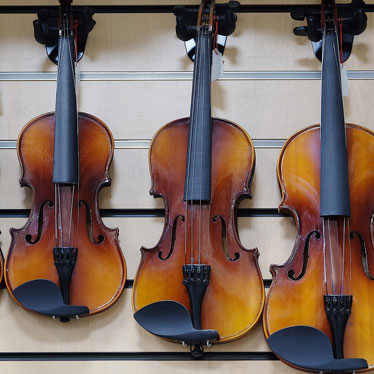Which Features and Comparisons Help People Decide Which Violin to Buy?

String instruments each have their own unique set of characteristics that contribute to the overall sound and “voice” of the instrument. The level of skill, attention to detail, and artisan workmanship used in the making also help determine the instrument’s value and personal worth. And although violins and other bowed instruments sport a wide range of quality, they are broadly classed as being either a student, intermediate, or a professional model.
However, those classifications are still rather expansive, so it’s often challenging for people who lack experience to know exactly what to look for when buying a violin. Obviously, you want to listen to its sound, but by
also knowing the aspects that are used to make comparisons between violins, you’ll be able to identify the key features that indicate an exceptionally crafted instrument as well.
Materials
Quality made violins are created using specific woods. Centuries of artisans have recognized and utilized the particular strength and resonant properties present in certain species of Spruce, so the violin’s top (or front) plate is crafted from it, while the sides (ribs), back plate, and neck are typically created from Maple. The strong, yet beautiful grains in Maple make it a particularly adept material for showcasing the “flaming” technique that gives a certain glow and distinctive appearance to the body of the instrument. Plus, it also has musical properties that allow it to resonate well.
Violins that are constructed with alternative woods do not project the same quality of sound, nor are they as playable as quality crafted instruments.
In addition to the type of material used, another factor that contributes to the cost and quality of the violin is the amount of time the wood has been allowed to cure. Great sounding instruments are created from Spruce and Maple that has been cured for at least five years. And although each Luthier (an artisan workman who crafts string instruments) has his or her own specific preferences, the general rule is that the longer the curing time (how long the wood is allowed to age before it’s used), the more exclusive and expensive the final instrument will be.
Other woods are used to fabricate the chin rest, peg box, and fingerboard, but ebony is traditionally the most coveted. It is used on the highest quality instruments, even at the beginner level for its lightweight, yet startlingly beautiful appearance.
Craftsmanship
The craftsmanship used is also a factor in deciding which violin to buy. Poorly fitted joints (where the top and bottom plate meet the ribs) can impact the clarity and strength of the sounds produced on the violin. Buyers should look for tight joining, especially where the neck is connected.
Depending on the age of the instrument, the special “hide” glue used to hold the pieces together is designed to “crack,” which allows the luthier to make adjustments and repairs to the violin. So, although the violin may have a seam separation, that doesn’t necessarily mean that it is an inferior model. It may just need re-gluing. However, the way all of the pieces are fitted together as a unit influence the quality and sound of the instrument. Some additional “clues of quality” that are looked for include:
- Deep, detailed scroll work
- The quality of the perfling—inlaid is best, but many quality instruments have it painted on
- Clear, smooth varnish—the varnish protects the wood and effects the resonance of the instrument
The overall symmetry of the violin is also a factor for consideration. An imaginary line drawn from the tip of the scroll to the bottom nut (the tip of the tailpiece) should create equal, almost exact proportions on both sides.
Set up and Accessories
How a violin is “fitted out” or “set up” also impacts its sound and quality. This process involves shaving and shaping the bridge piece to fit exactly on the top plate, making adjustments to the soundpost location inside the body of the violin (if necessary), fitting the pegs properly, stringing the violin, and other fine tuning tasks that make the violin ready to play.
Although these steps are needed from time to time, the attention used during the set up make an impression because they impact both the playability and sound of the instrument. For example, if the bridge isn’t placed correctly over the soundpost and bass bar, the violin won’t resonate well, creating a poor sound.
The quality and type of the materials used and the way they are put together help people compare violin differences, and knowing the factors that create those differences can help you understand what to look for when you are ready to buy.

